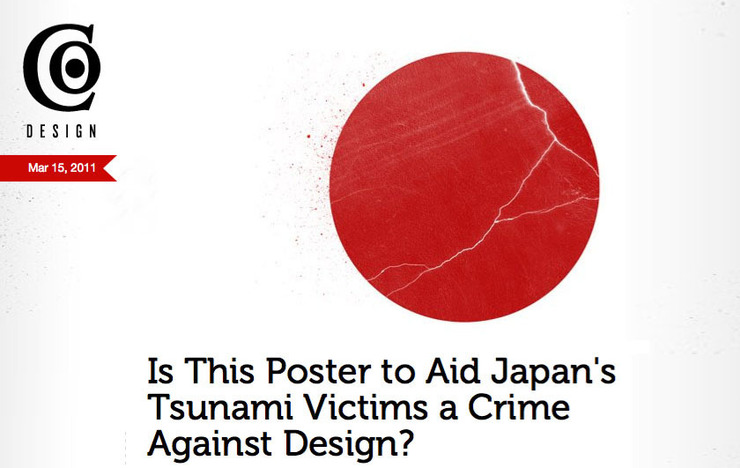
this image was taken from fastcodesign.com I have been learning about a lot of things in last ten days. I have been learning a lot about what has happened in Japan. I have learned how to watch TV news on my iPod, how to get my calls go through to my parents without busy signal (sometimes I have to call like 10 times), or collect enough information from various sources to assess what is right, what is wrong and what is just pure lie. But more importantly, I have been learning a lot about responsibility of art and being an artist. This is a rare moment when I look at the world and the world of art and design from a victim’s point of view. Well, I am technically not a victim. My family and friends are doing OK, although going though some tough times and inconveniences. I don’t even know a single person in the area directly hit by this disaster. Yet, the world outside Japan sees “Japan as the victim” and treat us, Japanese people abroad, as victims, and therefore, for the first time (and hopefully the last time) I am seeing the world from a completely different point of view. I contribute illustrations to newspapers and news magazines. I do illustrate tough topic like ongoing war. But I have never had a chance to stand on the point of the view of what has getting illustrated. And then I got this link to Fast Company blog post by John Pavlus. He captured my unorganized thoughts for the last ten days into very easy to read article which makes you think, regardless of you agree with him or not. I wanted to share this with you, especially that those who are reading this are mainly people in the creative field. http://www.fastcodesign.com//1663419/is-this-poster-to-aid-japans-tsunami-victims-a-design-crime I personally do not mind the specific poster in question here. At the same time, I cannot agree more with Mr. Pavlus’ view toward design (in general) during the time of disaster, and responsibility of the artists who create them. Aren’t some of the designs popping up on my and your facebook links, just too quick, too easy, and too smart, and sometimes feel like each designer is rushing to create the most clever image? Doesn’t it sometimes feel like it is a competition of a sort? Did they even have enough time to research the subject matter, do they know about the specific areas in Japan and culture, or did they think through of what was the message in the images before creating the images in rush? If it it was too long to read my mumbling, you can skip and just read here: During the time of disaster, those who are affected need to see sympathy, hope and encouragement more than anything. The last thing they want to see is another image of disaster, like a blood spilling flag. This is something I have learnd that wanted to share with you today. Let us show them hope. Because with our pens and brushes and computer mouse, we can. Thank you very much for those who read all the way down to here. PS (this section was added later) Thank you for all your comments. I know, once a blog post is up and people start commenting, it start to take life of its’ own, and people do start talking on the topics that were not necessarily the intention or the main topic of a post. But that is just the nature of it. I just wanted to add this section (previous section is the original post, I have not touched or revised it.) to explain my intention. It is not an attack against the creator of the poster that I used the image of (I used it because it was the top page of the original post by John Pavlus). I did mention that I did not mind the particular poster (actually, it is one of the better ones). And, whatever done for charity, and raising money: great. I am not complaining about the charity itself, and I believe neither did the original author John Pavlus. Whatever good intention rules, no doubt about that. I know people have ideas toward whether it is an exploitation, shameless self promotion, etc, etc, well, I have no comment on that, that was not the part of my intent on this post. It is the images (self-initiated) themselves, initiated by thousands of pro and armature artists and designers, popping up on internet even quicker than the actual detail of disasters unveils (it is ongoing), and many of them (not all, but many) seem so quick, so careless, so research less, and often feels like people are on competition who is the one to post the most clever ideas the fastest. How many of those who had created them can explain the meaning and controversial feelings of Japanese people toward the Hinomaru flag. Or, know about the area of disaster. Like, if you ask any American about the area where Katrina hit, they have pretty good idea and knowledge… for example.) Most importantly, I wanted to know that the people who are facing disasters in far away land need encouragement, support, hope and sympathy more than anything. I wanted each artist who is reading this, or thinking of creating some art/design work related to this or any other disasters happening around the world, to have that in mind when creating.
March 22, 2011

